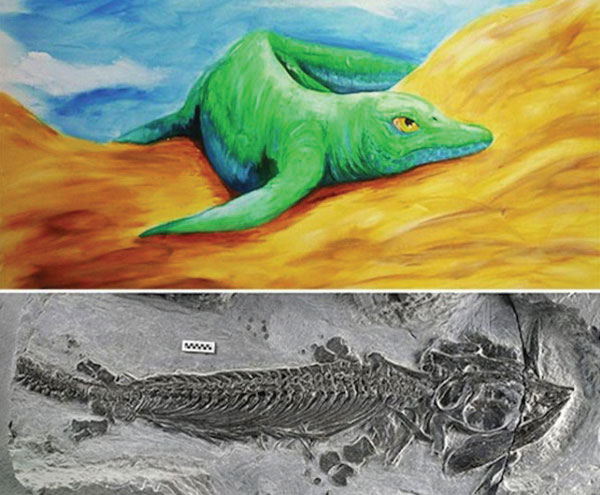Discovery in Anhui sheds light on two scientific mysteries
By Chris Davis (China Daily USA) Updated: 2014-11-20 13:33
|
The fossil of a 248 million-year-old reptile hints at how life bounced back from Earth's worst mass extinction. Stefano broccoli / university of Milan / Ryosuke Motani / UC Davis |
Ever since farmers in Xi'an accidently discovered what turned out to be a vast army of terracotta warriors, the world has gotten pretty used to treasures being unearthed in China, with its rich and mysterious past.
Recently, an international team of paleontologists working at the Majiashan Quarry outside of Hefei city in Anhui province unearthed a different kind of treasure, one that provides a missing link and helps begin to answer a couple of big questions.
The first involves the mighty and ferocious Ichthyosaur, the giant dolphin-shaped reptile that ruled the Jurassic oceans - just as T-Rex ruled the land - during the age of the dinosaurs 150 million to 200 million years ago. Nicknamed "Sea Monsters", they were as long a tractor trailer, armed with a long snout and jaws filled with teeth and propelled by four powerful fins and a tail that made them deadly swift swimmers.
Just like whales and dolphins which evolved from land mammals that took to the water, Ichthyosaurs were air-breathing and gave head-first birth to live young - another fact evidenced by fossils found in Anhui.
 Based on fossil evidence, scientists knew that Ichthyosaurs had also evolved from terrestrial reptiles that at some point had taken to the seas. But there has never been any evidence of the transitional creature that made the first move. Until now.
Based on fossil evidence, scientists knew that Ichthyosaurs had also evolved from terrestrial reptiles that at some point had taken to the seas. But there has never been any evidence of the transitional creature that made the first move. Until now.
Leading a team of scientists from the United States, China and Italy, Prof Ryosuke Motani of the University of California, Davis, announced in the journal Nature last week that they had found the missing link.
Dubbed Cartorhynchus lenticarpus, it is the smallest Ichthyosaur ever found, its total body length being a mere 16 inches, and it's about 248 million years old, a key date.
"When I first saw the animal, I was really puzzled," Motani told National Geographic, which helped fund the work.
Unlike its giant descendants who were completely adapted to a predatory life in the sea, this reptile had proportionately large flippers with flexible "wrists" that allowed it to move about on land much as seals and walruses do.
"There nothing that prevents it from coming onto land," said Motani in a statement released by UC-Davis. "Now we have this fossil showing the transition."
It also has thicker bones, which lines up with the idea that most land reptiles that transitioned to the sea became heavier with stubby limbs and thicker ribs to allow them to swim through the rough coastal waves and reach deep food-rich waters.
With that body shape, however, the creature probably wasn't a very fast swimmer and likely lived on shrimp and soft bottom-dwelling creatures on the seabed. The skull shape suggests what scientists call a suction feeder, in effect vacuuming up prey, a far cry from their descendants who would have their pick of the ocean's menu.
Motani made the point that this discovery goes beyond providing a missing piece to an evolutionary puzzle. It begins to answer an even greater mystery.
This animal lived 4 million years after the most cataclysmic event in Earth's history, the Permian-Triassic mass extinction 252 million years ago - colloquially knows as "the great dying" - when more than 96 percent of all marine species and 70 percent of all terrestrial species went extinct.
Scientists are hungry for evidence of how long it took animals and plants to bounce back from that catastrophic die-off, particularly since the extinction was associated with global warming.
"This was analogous to what might happen if the world gets warmer and warmer," Motani said. "How long did it take before the globe was good enough for predators like this to reappear? In that world, many things became extinct, but it started something new. These reptiles came out during this recovery."
In addition to UC-Davis, the research team included scientists from Peking University, Anhui Geological Museum, the Chinese Academy of Science, University of Milan and the Field Museum in Chicago. The study was funded by the National Geographic Society, the National Natural Science Foundation of China, Nanjing Institute of Geology of Palaeontology and Anhui province.
Contact the writer at chrisdavis@chinadailyusa.com.











